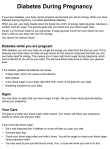Wishing everyone happy holidays and a joyful New Year from the Healthify team. Don't forget to Slip, Slop, Slap and Wrap!
Diabetes – gestational
Gestational diabetes – diabetes that develops during pregnancy | Mate huka i te hapūtanga
Key points about gestational diabetes
- Gestational diabetes (mate huka i te hapūtanga) is when a pregnant woman who was not known to have diabetes before pregnancy develops high blood glucose levels during pregnancy.
- It is different from pre-existing diabetes and pregnancy, which is when you have diabetes (type 1 or type 2 diabetes) before you get pregnant.
- Gestational diabetes affects about 4%–8% of all pregnant women. Untreated, it can lead to problems for both mother and baby.
- Treatment includes healthy eating and exercise, and possibly the use of medicine including injected insulin.
- Gestational diabetes usually goes away after your baby is born; however, it can recur in future pregnancies.

During pregnancy your body needs extra insulin. If your body can't produce enough of this extra insulin, glucose from the food you eat can't enter the cells to be used as energy by you and your baby, and the glucose level in your blood increases. Read more about insulin deficiency on the type 1 diabetes page.
Untreated, high blood glucose levels can lead to problems for both parent and baby. Treatment includes healthy eating and exercise, and possibly the use of medicine including injected insulin.
Gestational diabetes usually develops in the second or third trimester of pregnancy and goes away after your baby is born. However, it can recur in future pregnancies and it's important to know you are at higher risk of developing diabetes in later years.
You are more likely to get gestational diabetes if you:
- are very overweight
- gain excessive weight during pregnancy
- have a family history of diabetes
- are over 30 years of age (the risk is even higher if you're over 40)
- have had gestational diabetes in a previous pregnancy
- have had an unexplained stillbirth or a miscarriage before
- have had a large baby (over 4 kilos) before
- belong to a high risk ethnic group (Indo-Asian, Māori, Pacific Peoples, Middle Eastern)
- have polycystic ovarian syndrome.
Gestational diabetes can also occur with none of these risk factors. If you had gestational diabetes in an earlier pregnancy, you should be tested as soon as a new pregnancy occurs.
You don’t usually get any symptoms from gestational diabetes, but sometimes symptoms of very high blood glucose (hyperglycaemia) do occur, eg, feeling very thirsty, needing to wee/mimi often, dry mouth, tiredness, blurred eyesight, itching in the vaginal area or thrush.
Anyone who is pregnant should be offered a blood test for glycated haemoglobin (HbA1c) before 20 weeks of pregnancy as a routine part of antenatal (pregnancy) care. This will help identify previously undiagnosed diabetes or prediabetes as well as finding people who are at high risk of developing gestational diabetes later in pregnancy.
At 24–28 weeks of pregnancy, you may be offered a further blood test to check for diabetes.
If gestational diabetes is untreated, the high blood glucose levels can cause problems at different stages.
During your pregnancy
- Overfeeding of your baby while it is in the womb, so that the baby grows much larger than average (macrosomia).
- Premature birth (baby being born before 37 weeks).
- Higher rate of miscarriage (before 23 weeks) and stillbirth (baby dying before birth).
During delivery
- Large babies are more likely to have difficult births, with a need for surgical (caesarean section) or assisted delivery.
- Shoulder dystocia can occur. This is a serious complication during birth when the baby’s head passes through the vagina (birth canal), but their shoulder gets stuck behind the pelvic bone (the hips and ring of bone that supports your upper body). When this happens, both parent and baby are at risk of serious injury.
After birth
- Babies can suffer from low blood glucose within the first day or two and need closer monitoring.
- Breathing problems are also more common shortly after birth.
Late effects
- Babies are at increased risk of developing diabetes or obesity (having a body mass index of more than 30) later in life.
- If you have had gestational diabetes you're also at much higher risk of developing diabetes in the future.
It's recommended that everyone eats the correct amount of a balanced, healthy diet and has some exercise most days of the week to stay in the best health. This is particularly important during pregnancy to help prevent gestational diabetes. If gestational diabetes is diagnosed, the first treatment offered is specialised diet and lifestyle advice. The aim is to keep blood glucose levels in the normal range (equal to those of a pregnant person who doesn't have gestational diabetes).
If diet and exercise alone don't keep your blood glucose within the target range, then metformin and or insulin may be added. Your care will be provided in consultation (including virtual clinics) with an obstetrician, a physician and a dietitian as well as by your lead maternity carer (LMC). Read more about taking metformin for gestational diabetes.(external link)
Following the treatment advice increases the chances of a healthy pregnancy and birth, and helps your baby avoid future health problems. It will also help avoid the complications listed above.
Gestational diabetes usually goes away after pregnancy. You should have a blood test at 3 months after delivery and have your HbA1c level tested every year to check. For 20-30% of people who had gestational diabetes it doesn't go away and permanent diabetes can occur. These people will need to continue with diabetes treatment after pregnancy.
Knowing you have an increased risk of type 2 diabetes means you can take steps towards trying to prevent it by:
- controlling your body weight
- making healthy food choices
- taking regular exercise.
Pregnancy topics
Diabetes topics
Healthy eating basics
Gestational diabetes(external link) Diabetes NZ
Introduction to gestational diabetes(external link) NHS Choices, UK
Gestational diabetes(external link) Health New Zealand | Te Whatu Ora
Resources
Brochures
Diabetes in pregnancy – gestational diabetes(external link)(external link) Health Information Translations, US, 2016 English(external link), Arabic/English(external link), Chinese (simplified)/English(external link), Chinese (traditional)/English(external link), French/English(external link), Japanese/English(external link), Korean/English(external link), Russian/English(external link), Somali/English(external link), Spanish(external link), Ukrainian/English(external link), Vietnamese/English(external link)
Gestational Diabetes(external link) Health New Zealand | Te Whatu Ora, 2021
Diabetes during pregnancy (in 12 languages)(external link) Health Information Translations, US, 2009 - 2016 Available in 12 languages(external link)
Safe and healthy eating in pregnancy(external link) Health New Zealand | Te Whatu Ora, 2023
Diabetes & healthy food choices(external link) Diabetes NZ, 2019 English(external link), Chinese(external link)
Taking metformin for gestational diabetes(external link) Ministry of Health NZ, 2017 te reo Māori(external link), Samoan(external link)
Love don't judge(external link) Diabetes New Zealand
Apps/tools
BMI calculator
Diabetes apps
Pregnancy, baby care and parenting apps
References
Gestational diabetes(external link) NHS, UK
Screening, diagnosis and management of gestational diabetes in NZ – a clinical practice guideline(external link) Health New Zealand | Te Whatu Ora
Gestational diabetes(external link) Diabetes NZ
Monitoring diabetes before, during and after pregnancy(external link) BPAC, NZ, 2015
Māori health literacy research: Gestational diabetes mellitus(external link) Health New Zealand - Te Whatu Ora, 2023
Screening, diagnosis and management of gestational diabetes in NZ – a clinical practice guideline(external link) Health New Zealand | Te Whatu Ora
Gestational diabetes(external link) NICE guidelines, UK
Seminars
Assessing and managing maternity conditions – obesity and GDM(external link) Pharmac seminar, NZ, 2018
Assessing and managing maternity conditions – NZ GDM guidelines(external link) Pharmac seminar, NZ, 2018
Apps
Brochures

Ministry of Health and Health Promotion Agency, NZ, 2022

Diabetes in pregnancy – gestational diabetes(external link) Health Information Translations, US, 2016
English(external link), Arabic/English(external link), Chinese (simplified)/English(external link), Chinese (traditional)/English(external link), French/English(external link), Japanese/English(external link), Korean/English(external link), Russian/English(external link), Somali/English(external link), Spanish(external link), Ukrainian/English(external link), Vietnamese/English(external link)
Note: This resource is from overseas so some details may be different in New Zealand, eg, phone 111 for emergencies or, if it’s not an emergency, freephone Healthline 0800 611 116
Credits: Healthify editorial team. Healthify is brought to you by Health Navigator Charitable Trust.
Reviewed by: Claire Salter, Pharmacist, Tauranga
Last reviewed:
Page last updated:






